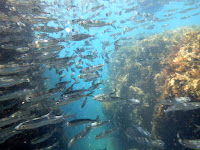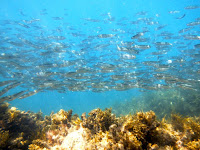What we found instead of our anticipated beam reach was a whole lot of flat calm. This was interspersed with two-minute bursts of winds coming from exactly the opposite direction from the six different forecasts I had checked during the wee hours before our departure. Grr! Each time I started to wind down the engine, I would just be reaching for the stop handle when the wind would disappear and I’d have to bring it back up to power.


A calm day at sea
We finally made it to the northern edge of the Smith Islands, most of which have Smith in the names: Blacksmith, Ladysmith, Anchorsmith, Locksmith. They also have Goldsmith, Silversmith, Coppersmith and Tinsmith. There, the predicted wind finally filled in and at long last, the engine was able to rest.
We had a boost from the flooding tide, which was good. The bad part was that it was also setting us westward, which meant we weren’t able to hold our course while close-hauled on the port tack. I was determined not to resort again to the engine, so we started a series of disappointing tacks.
Each starboard tack turned us into the current, which mostly slowed us way down, but also set us sideways towards our last line. That made our course over the ground a series of one hundred and sixty-degree turns. It was hard to be patient when sailing almost exactly away from where we wanted to go.
The third time that we passed Coppersmith Rock, the wind backed enough to send us going back toward Long Island. That was good. We tacked and now were not only able to crab into the current enough to clear Locksmith Island, we could even let out the sails just a little, which boosted our speed dramatically.
Our plan was to then go into the strait between Linne Island (just plain Linne, no Smith) and Goldsmith Island to a small anchorage on Goldsmith’s south side. That anchorage was reputed to only have room for a few boats. We could already see one there on AIS, plus at least another two that were going to beat us there. There were also two or three more that didn’t have AIS that seemed to be heading for the same spot as well. Rather than try to wedge ourselves in amongst them, we changed plans and headed for Tinsmith Island, four miles further along.
The rocky bowl of the bay there on the southeastern side was empty when we arrived. We crossed the line marking the edge of the fast tidal stream churning by and then very gingerly sounded the bay (The chart is very vague). The depths we liked were way too close to the rocks. The distance we like was pretty deep. Since there was no pub ashore and since a lot of the bays around here are filled with coral, we opted to set our anchor in the deep part at the middle of the bay, where the bottom would hopefully be clear of any coral. We then let out our whole length of chain. The water was pretty murky, so we set the anchor and hoped.

Anchored off Tinsmith Island
As soon as we were secure, I pulled myself down the chain. The first thing to emerge out of the murk was a big bommie, made out of brain and elkhorn coral. Uh, oh! Before I got there, the chain curved away and touched the bottom in gravel and sand. I pulled myself a few meters further before I had to let go and surface again. The bottom was mostly coarse sand, but there was a scattering of coral heads here and there that I didn’t like.
I went down a second time, found the chain and followed it another ten meters or so along sand with widely-spaced bommies before I had to go up again. On my third and fourth attempts, I couldn’t even find the chain. I changed tactics and swam to the beach. As soon as it was shallow enough, a bottom made up almost entirely of coral rose into view. Oh, that ain’t good…
Swimming back towards Begonia, I picked three or four places to dive down and follow the coral as the bottom fell away. Each one eventually leveled off to an area that was mostly sand, but still had a few coral heads here and there. I had gone from urban to rural, coral-wise. Since Begonia was holding well at the same distance as our rode length (thus no knots or wraps), and since we had dropped it at the same depth as the mainly sandy area (about twelve meters), we hoped everything was okay down there.
Of course, I didn’t sleep well, imagining that our anchor was wedged in a hole surrounded by walls of coral. Instead of sleeping in, which is what I really wanted to do, I was up early to catch the lowest of the low tides that we would have here. I had formulated a plan.
With the shallower depth, I took a long line with a ball fender on one end and a Wichard hook on the other, pulled myself down and then along the chain as far as I could, hooked the float to the chain there and then returned to the surface.
Once I caught my breath, I would pull myself back down the line, unhook it from the chain, and then pull myself another ten meters or so along the chain before reattaching the line and heading for the surface. In this way, after several repeats, I was finally able to find our anchor sitting half-buried in the coarse sand. I left the buoy there to mark its location.
We got really lucky. There is still a lot of coral down there, all of which needs humanity to pay special attention to its welfare. I would say the chance of not hitting a bommie with the anchor at Tinsmith is maybe 60%. Not laying the chain down on some of it would decrease that to about 10%. Knowing what I know now, I would not anchor here again or recommend anybody do so without sending a swimmer down with the anchor to make sure it hits a sandy spot, and then watching where the chain goes as it’s paid out slowly.
With that done, and since it was low tide anyway, Maryanne and I set out to explore the shallows ringing the bay. While much of the coral was silted up, we found several sections where the water clarity improved, revealing colorful heads rich with diversity of types and hosting several different species of darting fishes.
Our favorite spot was on the east wall. Swimming in opposite directions through a crevice between boulders, we came across a bait ball of little silver fish. They whirled around trying to confuse us as the ball spun. Then they realized that they had no choice. They split up and headed at each of us in two flashing streams. I could actually hear the turbulence as they zoomed past my ears. It sounded like a babbling brook. By the time we returned to that same spot on our homeward pass, they were back in their hiding place again so we got to do the whole thing twice.
It just occurred to me that when fish do that, it should be called a swimpede.







Snorkelling the shallows AND among the crowds of fish
Knowing that our anchor and chain were not fouled made the rest of the stay in our private little cove at Tinsmith downright relaxing. We had just enough internet to do some work, without feeling like we had to do the whole set. We wrote and watched the wavelets and eddies in the current as it streamed past the bay. Inside, we enjoyed the antics of the chattering birds, jumping fish and surfacing turtles. At sunset, it was a perfect place to enjoy the solitude over a glass of wine.

No comments:
Post a Comment